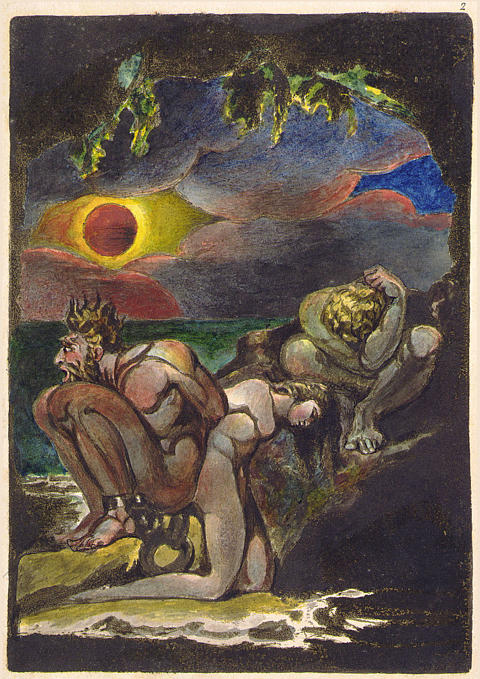Visions Of The Daughters Of Albion on:
[Wikipedia]
[Google]
[Amazon]
''Visions of the Daughters of Albion'' is a 1793 poem by 
Romanticism and Colonialism, edited by Tim Fulford and Peter J. Kitson
/ref>
Information and Comparisons of extant copies of the hand-illustrated poem
at the
Text of ''Visions of the Daughters of Albion''Digital Facsimile
of ''Visions of the daughters of Albion'' bound with ''Book of Thel'', Lowell *EC75.B5815.793va.
Houghton Library
at Harvard University. {{Authority control Poetry by William Blake 1793 poems 1793 books
William Blake
William Blake (28 November 1757 – 12 August 1827) was an English poet, painter, and printmaker. Largely unrecognised during his life, Blake is now considered a seminal figure in the history of the poetry and visual art of the Romantic Age. ...
, produced as a book with his own illustrations. It is a short and early example of his prophetic books
The prophetic books are a division of the Christian Bible, grouping 18 books ( Catholic and Orthodox canon) or 17 books (Protestant canon, excluding Baruch) in the Old Testament. In terms of the Tanakh, it includes the Latter Prophets from the ...
, and a sequel of sorts to ''The Book of Thel
''The Book of Thel'' is a poem by William Blake, dated 1789 and probably composed in the period 1788 to 1790. It is illustrated by his own plates, and compared to his later prophetic books is relatively short and easier to understand. The metre ...
''.

Plot
The central narrative is of the female character Oothoon, called the "soft soul of America", and of her sexual experience. S. Foster Damon (''A Blake Dictionary'') suggested that Blake had been influenced byMary Wollstonecraft
Mary Wollstonecraft (, ; 27 April 1759 – 10 September 1797) was a British writer, philosopher, and advocate of women's rights. Until the late 20th century, Wollstonecraft's life, which encompassed several unconventional personal relationsh ...
's ''A Vindication of the Rights of Woman
''A Vindication of the Rights of Woman: with Strictures on Political and Moral Subjects'' (1792), written by British philosopher and women's rights advocate Mary Wollstonecraft (1759–1797), is one of the earliest works of feminist philosop ...
'', published in 1792.
Oothoon is in love with Theotormon, who represents the chaste man, filled with a false sense of righteousness. Oothoon desires Theotormon but is suddenly, violently raped by Bromion. After Oothoon is raped neither Bromion nor Theotormon want anything to do with her.
Symbolism
As is usual in Blake, the names of the characters represent their symbolic roles. Theotormon's name is derived from the Greek ''theos'', which means "god", and the Latin ''tormentum'', which means "twist" or "torment". The name of his rival Bromion is Greek meaning "roarer". Bromion represents the passionate man, filled with lustful fire. Oothoon is the representation of a woman in Blake's society, who had no charge over her own sexuality. Blake has the Daughters of Albion look to the West, to America, because he believed that there was a promise in America that would one day end all forms of discrimination. It was to be in America, that races would live in harmony, and women would be able to claim their own sexuality. At the same time, Blake recognizes that though America has freed itself from British rule, it continues to practice slavery. Blake used Plato'sAllegory of the Cave
The Allegory of the Cave, or Plato's Cave, is an allegory presented by the Greek philosopher Plato in his work ''Republic'' (514a–520a) to compare "the effect of education ( παιδεία) and the lack of it on our nature". It is written as ...
in ''Visions of the Daughters of Albion'' as a theme for the three characters not being able to understand the true nature of reality, without being hindered by convention. It has been argued that Theotormon is a mythicised version of John Stedman, whose book about his experience of slavery and brutality in Suriname on the coast of South America was being illustrated by Blake at the time./ref>
Trivia
* Bromion is a title used forDionysos
In ancient Greek religion and myth, Dionysus (; grc, Διόνυσος ) is the god of the grape-harvest, winemaking, orchards and fruit, vegetation, fertility, insanity, ritual madness, religious ecstasy, festivity, and theatre. The Romans ...
; it means the "loud-roarer".
*The edition was very small, and copies have been individually traced.
Notes
External links
Information and Comparisons of extant copies of the hand-illustrated poem
at the
William Blake Archive
The William Blake Archive is a digital humanities project started in 1994, a first version of the website was launched in 1996.{{cite journal, last1=Crawford, first1=Kendal, last2=Levy, first2=Michelle, journal=RIDE: A Review Journal for Digital E ...
Text of ''Visions of the Daughters of Albion''
of ''Visions of the daughters of Albion'' bound with ''Book of Thel'', Lowell *EC75.B5815.793va.
Houghton Library
at Harvard University. {{Authority control Poetry by William Blake 1793 poems 1793 books